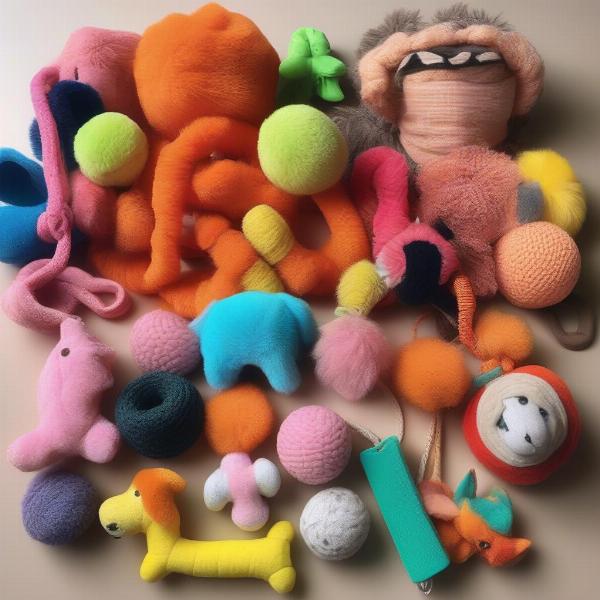Dog chew bones are a popular treat for our furry friends, but with so many options available, it can be overwhelming to choose the right one. This comprehensive guide will explore the benefits, risks, and various types of dog chew bones, empowering you to make informed decisions for your canine companion’s health and happiness. We’ll delve into everything from selecting appropriate sizes and materials to understanding the potential hazards and how to mitigate them.
Why Do Dogs Love Chew Bones?
Chewing is a natural instinct for dogs, fulfilling several essential needs. Puppies use chewing to relieve teething discomfort, while adult dogs chew to alleviate boredom, anxiety, and stress. Chewing also helps maintain dental hygiene by scraping away plaque and tartar, promoting healthier gums and fresher breath. Furthermore, the act of chewing releases endorphins, which have mood-boosting and pain-relieving effects, contributing to your dog’s overall well-being.
Choosing the Right Chew Bone for Your Dog
Selecting the appropriate chew bone is crucial for your dog’s safety and enjoyment. Consider your dog’s size, age, and chewing habits when making your choice. large dog chew bones are essential for larger breeds to prevent them from swallowing the bone whole. For puppies, opt for softer, more pliable chews designed for their delicate teeth and gums.
Size Matters
Always choose a chew bone that is larger than your dog’s mouth to prevent choking hazards. Avoid bones that can be easily broken into small pieces, which can be swallowed and cause digestive issues or blockages. For aggressive chewers, durable nylon or rubber bones are excellent options.
Material Considerations
Dog chew bones are made from various materials, each with its own pros and cons. big dog chew bones often come in durable materials like nylon and rubber. Natural bones, such as beef or bison bones, offer nutritional benefits but can pose a higher risk of splintering. Rawhide chews are popular but can be difficult to digest for some dogs. Always supervise your dog while they are chewing any type of bone.
Potential Hazards and Safety Precautions
While chew bones offer numerous benefits, they also come with potential risks. Splintering bones can cause injuries to the mouth, throat, or digestive tract. dog bones without rawhide are a good alternative for dogs with sensitive stomachs. Some dogs may also develop digestive upset from certain types of chew bones. Always supervise your dog while they are chewing and remove the bone if it becomes too small or starts to splinter.
Rawhide Concerns
Rawhide chews can be a choking hazard, especially for aggressive chewers. They can also be difficult to digest and may cause blockages. If you choose to give your dog rawhide, opt for high-quality products and always supervise them. raw dog bone should be chosen with care.
Alternatives to Traditional Chew Bones
If you are concerned about the potential hazards of traditional chew bones, several alternatives are available. Dental chews, designed to promote dental health, are a safer option. real bones for dogs offer a natural chewing experience but should be carefully selected and monitored. Durable rubber toys can also satisfy a dog’s chewing instinct while providing a safe and long-lasting alternative.  Dog chew toys
Dog chew toys
Conclusion
Dog chew bones can provide numerous benefits for your canine companion, from promoting dental health to alleviating boredom and anxiety. However, it is essential to choose the right type of chew bone and take appropriate safety precautions. By understanding the potential risks and benefits, you can make informed decisions that ensure your dog’s chewing experience is both enjoyable and safe. Remember to always supervise your dog while they are chewing and consult with your veterinarian if you have any concerns.
FAQ
- What are the best chew bones for puppies? Soft, pliable chews made from rubber or nylon are ideal for puppies.
- Can I give my dog cooked bones? No, cooked bones can easily splinter and cause serious internal injuries.
- How often should I give my dog a chew bone? This depends on your dog’s individual chewing habits and the type of chew bone.
- What should I do if my dog swallows a bone splinter? Contact your veterinarian immediately.
- Are there any alternatives to rawhide chews? Yes, dental chews, durable rubber toys, and certain natural bones are safer alternatives.
- How can I tell if a chew bone is too small for my dog? If the bone can fit entirely inside your dog’s mouth, it is too small.
- What are the signs of digestive upset from a chew bone? Vomiting, diarrhea, and loss of appetite can indicate digestive issues.
About ILM Dog
ILM Dog is your trusted international resource for all things dog-related. We provide expert advice on dog breeds, health and medical care, training, nutrition, grooming, exercise, and much more. Whether you’re a new dog owner or a seasoned expert, our website offers practical, reliable information to help you provide the best possible care for your canine companion. From selecting the perfect breed to understanding their unique health needs and behavioral patterns, ILM Dog empowers you to navigate the wonderful world of dog ownership with confidence. We also offer insights into various dog products and accessories to enhance your dog’s life. Contact us today at [email protected] or +44 20-3965-8624 for personalized guidance.